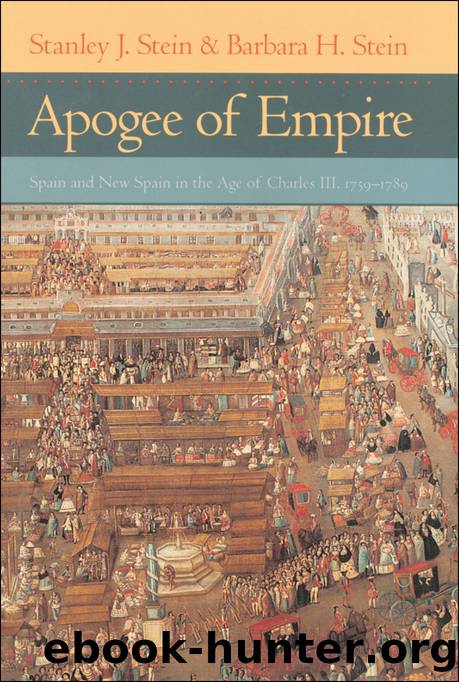Apogee of Empire by Stanley J. Stein & Barbara H. Stein

Author:Stanley J. Stein & Barbara H. Stein [Stein, Stanley J. & Stein, Barbara H.]
Language: eng
Format: epub
ISBN: 9780801881565
Publisher: JohnsHopkinsUP
Published: 2003-09-15T05:00:00+00:00
The Tribunal de MinerÃa
The immediate origins of what became New Spainâs mining tribunal were the industryâs capital shortages as well as cost-reduction imperatives. These, it may be argued, were aspects of the boom-and-bust cycleâperennial problems of any large-scale enterprise. Yet this apparently static perspective on New Spainâs major economic sector obscures factors making the last seventy-five years of colonial rule in New Spain both novel and crisis-prone, such as the surge in output that began with the extraordinary development of Guanajuatoâs âValencianaâ and Zacatecasâs âVeta Grandeâ mines, both requiring large-scale investment in infrastructureâincluding timbering, drainage, and whims. In this sense, New Spainâs silver-mining sector in Gálvezâs time was entering a new phase, the apogee of more than two centuries of activity. Another factor was the more general, nebulous, but nonetheless real pressure of private and public peninsular interests to offer the metropole and the growing numbers of emigrants from the montañas de Santander and the Basque regions greater opportunity in wealth-producing sectors of Spainâs colonial possessions, notably (but not exclusively) in New Spain. In this connection, at least four interest groups were not hard to define: Creole mine owners and their Mexico City almacenero backers, local silver refiners hoping to circumvent Mexico Cityâs commercial oligopolists, Cadiz flotistas pressing to enter mining as rescatadores, and recent immigrants from Spainâs Cantabrian provinces.
It was Gálvezâs successive roles as visitador general to New Spain, consejero of the Consejo de Indias, and then colonial secretary that led him to respond to private and public interest peninsular groups vitally involved in the economy of New Spain. Six years there had sensitized him to mine ownersâ problems. When he returned to Madrid, soon to become colonial secretary and seeming arbiter of colonial policy and its implementation, he kept in contact through former staff members in Mexico, including Joaquin Velázquez de León, a Creole who had served under him on his northern expedition. He could also rely on civil servants with substantial colonial service who occupied key positions in Madridâs high bureaucracy, among them Landázuri; Francisco Machado, who had also served under Gálvez in New Spain and later became a viceregal secretary before being recalled to Madrid; and Antonio Porlier, ex-oidor of the Audiencias of Charcas and Lima.62 Gálvezâs problem was not whether but how the state might intervene in the colonial mining sector in order to provide capital equitably, a judicial system attuned to mine ownersâ rather than almacenerosâ issues, and technical assistance, all the while circumventing the almaceneros of the Mexico City consulado and the Creole oidores of the Audiencia, notably Francisco Xavier Gamboa. In other words, how to block Gamboaâs proposed general supply company, likely to be dominated by the (largely peninsular) commercial oligarchs of the colonial capital; and to provide a degree of autonomy to mining districts precisely when a new wave of bonanza-seekers from Spainâs northern provinces were penetrating those districts.
Gálvez probably drafted the royal cédula (warrant) of November 1773 directing Viceroy Bucareli to choose a committee drawn from the key colonial bureaucracies,
Download
This site does not store any files on its server. We only index and link to content provided by other sites. Please contact the content providers to delete copyright contents if any and email us, we'll remove relevant links or contents immediately.
Room 212 by Kate Stewart(5040)
The Crown by Robert Lacey(4728)
Endurance: Shackleton's Incredible Voyage by Alfred Lansing(4683)
The Iron Duke by The Iron Duke(4293)
The Rape of Nanking by Iris Chang(4139)
Joan of Arc by Mary Gordon(4016)
Killing England by Bill O'Reilly(3953)
Say Nothing by Patrick Radden Keefe(3903)
I'll Give You the Sun by Jandy Nelson(3359)
Shadow of Night by Deborah Harkness(3306)
Hitler's Monsters by Eric Kurlander(3269)
Mary, Queen of Scots, and the Murder of Lord Darnley by Alison Weir(3152)
Blood and Sand by Alex Von Tunzelmann(3140)
Darkest Hour by Anthony McCarten(3072)
Eleanor & Park by Rainbow Rowell(3063)
Margaret Thatcher: The Autobiography by Thatcher Margaret(3029)
Red Famine: Stalin's War on Ukraine by Anne Applebaum(2874)
Book of Life by Deborah Harkness(2869)
The One Memory of Flora Banks by Emily Barr(2803)
